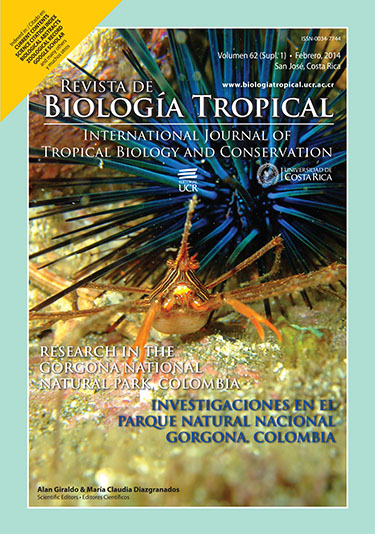Abstract
Eels and moray eels are among the species that lack commercial value but that are important as bait. However, little information is available about Colombian fishing by-products. Between 2005 and 2009, field work was done in Gorgona National Natural Park and its surrounding areas, with a fishing line made of traditional “J” and circular or curve hooks. We analyzed the catch composition, comparing both types of hooks, emphasizing whether the circular hook modified or not non-commercial captures. Overall, 189 fishing throws where analyzed, standardizing the Catch Per Effort (CPUE) in number of individuals and in kilograms per 100 hooks per hour of task. A total of 50 species where captured, of which 14 are part of the non-commercial category. There were no significant differences for hook types (U=25228, P>0.1), and Gymnothorax equatorialis and Echiophis brunneus were the most abundant species. Both were concentrated in the northern sector of the study area, a rocky banks sector. The mean sexual maturity size was 57.0cm in G. equatorialis, and at 85.6cm in E. brunneus. Rev. Biol. Trop. 62 (Suppl. 1): 391-405. Epub 2014 February 01.References
Aguilar-Palomino, B., Mariscal-Romero, J., González-Sansón, G. & Rodríguez-Ibarra, L. (1996). Ictiofauna demersal de fondos blandos de la plataforma continental de Jalisco y Colima, México, en la primavera de 1995. Ciencias Marinas, 22: 469-481.
Allen, G. R. & Robertson, D. R. (1994). Fishes of the tropical eastern Pacific. Crawford House Press, Bathhurst, Australia.
Bussing, W. A. (2000). Gymnothorax phalarus, a new Eastern Pacific moray eel (Pisces: Muraenidae). Revista de Biología Tropical, 46: 439-446.
Fischer, W., Krupp, F., Schneider, W. (1995). (Eds.). Guía FAO para la Identificación de especies para los fines de la Pesca, Pacifico Centro-Oriental (Vol. III. Partes 1 y 2). FAO, Roma, Italia.
Fishelson, L. (1992). Comparative gonad morphology and sexuality of the Muraenidae (Pisces, Teleostei). Copeia, 1: 197-209.
García, A. (2005). Aspectos biológicos y pesqueros de tres especies de anguiliformes: Gymnothorax equatorialis, Ophichthus frontalis y Echiophis brunneus en el Parque Nacional Natural Gorgona y su área de influencia, Pacífico colombiano (Tesis de pregrado) Universidad del Valle, Cali, Colombia.
Hatooka, K. & Randall, J. E. (1992). A new moray eel (Gymnothorax: Muraenidae) from Japan and Hawaii. Japanese Journal of Ichthyology, 39: 183-190.
Lavenberg, R. J. (1992). A new moray eel (Muraenidae: Gymnothorax) from oceanic islands of the South Pacific. Pacific Science, 46: 58-67.
Lucano-Ramírez, G., Ruiz-Ramírez, S., Rojo-Vázquez, J. A. & González-Sansón, G. (2008). Reproducción de la morena, Gymnothorax equatorialis (Pisces: Muraenidae) en Jalisco y Colima, México. Revista de Biología Tropical, 56(1): 153-163.
McCosker, J. E. & Rosenblatt, R. H. (1995). Muraenidae. In W. Fischer, F. Krupp, W. Schneider, C. Sommer, K. E. Carpenter & V. H. Niem (Eds.), Guía FAO para la identificación de especies para los fines de la pesca, Pacífico centro-oriental. FAO, Roma, Italia.
Rivas, M. I. (1998). Ecología Trófica de algunas especies de los PNN Gorgona y Sanquianga (Tesis pregrado). Universidad del Valle, Cali, Colombia.
Rojas, P. A & Zapata, L. A. (2006). Peces demersales del Parque Nacional Natural Gorgona y su área de influencia, Pacífico colombiano. Biota colombiana, 7(2): 211-244.
Ruiz-Ramírez, S., Lucano-Ramírez, G. & Mariscal-Romero, J. (1997). Length-Weight relationships of softbottom demersal fishes from Jalisco and Colima states, Mexico. Naga, The ICLARM Quarterly, 20: 62-63.
UAESPNN. (1998). Plan de Manejo del Parque Nacional Natural Gorgona. Ministerio del Medio Ambiente, Bogotá, Colombia.
Udupa, K. S. (1986). Statistical methos of estimating the size at first maturity in fishes. Fishbyte, 4(2): 8-10.
Vazzoler, A. E. A. M. (1981). Manual de métodos para estudos biológicos de populações de peixes: Reprodução e crescimento. Programa Nacional de Zoologia, Brasília, Brasil.
Williams, T. (1974). “One-man” measuring board. In: FAO (E.), Manual of fisheries Science. Part 2 Methods of Resource Investigation and their application (pp. 63-68). FAO Fisheries Technical Paper No. 115, Rome, Italy.
Zapata L. A., Rodríguez, G., Beltrán, B., Gómez, G., Angulo, W., Gómez, A., Ramírez, M., Morales, Y., Hung, M., Herrera, J., Riascos, C. (1999). Prospección de los principales Bancos de Pesca en el Pacífico colombiano, durante noviembre de 1998. Bol. Científico INPA, 6: 111-175.
Zapata, L. A., Caicedo, J. A., Rojas, P., Gómez, S., Castellano-Galindo, G., Lora, A. M., Baos, R. & Cuadros, L. (2010). Disminución del impacto por captura incidental de tortugas marinas con el uso de anzuelos curvos. Informe de País, Bogotá, Colombia.
Zorrilla, M. X. (1999). Aspectos reproductivos de algunos peces demersales del Parque Nacional Natural Gorgona, con énfasis en Gymnothorax sp. Aff. ecuatorialis (Pisces: Muraenidae) y Lutjanus argentiventris (Pisces: Lutjanidae) (Tesis de Grado). Universidad del Valle, Cali, Colombia.
##plugins.facebook.comentarios##

This work is licensed under a Creative Commons Attribution 4.0 International License.
Copyright (c) 2014 Revista de Biología Tropical






